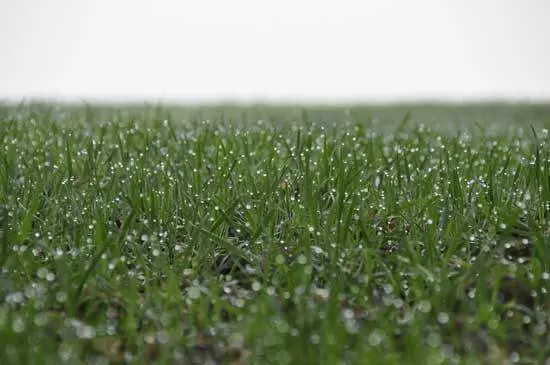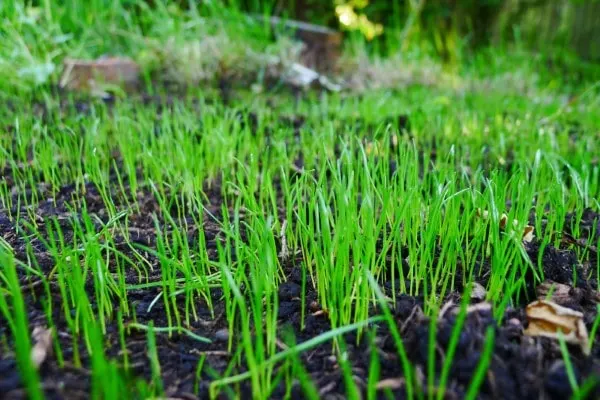You have finally managed to break out a small plot to build the lawn of your dreams and filled it with good quality soil. However, you don’t know the exact routine of watering the grass seed and filling your lawn with luscious grass for you to lay upon on the occasion of a bright sunny day.
Well, don’t you fear because we are here to provide you with the right guidelines to help you water your new grass seed and when to stop watering new grass seed to help you get that perfect lawn.

When To Stop Watering New Grass Seed?
How Much Water Is Too Much Water?
Understanding the correct amount of water that your newly germinated grass seeds require is very difficult. There are a number of factors that affect the amount of water required. If the soil is pretty dry, it can have the tendency to absorb the moisture that your grass seeds might be requiring.
If the weather is very cold or windy, the amount of water required will also be different from the actual amount of water.
If you water the seeds too much, there is the problem of water clogging which can cause the seeds to go bad. If the lawn is left bare without any form of moisture, the seeds will be forced to look for moisture deep down into the ground, which will also cause them to go dry and die sooner.
The lawn should be moist enough to prevent water clogging as well as a barren spell.
How to Water?
Since you have decided to build a lawn with the ideal grass seeds, you must also be prepared to buy a sprinkler for the same. There are a number of models of sprinklers that can help you water your lawns ideally with the stipulated amount of water.
You can set a timer for your sprinklers to water the lawn for a good 5-10 minutes in the early morning as well as during the midday to prevent excessive drying of the soil.
The grass seeds need a little time to germinate, but the actual grass formation takes a lot of dedication and a good amount of regular watering. We would recommend a sprinkler over a hand hose due to the wide spectrum of watering that sprinklers bring in with them with the amazing water handling capacity.
At the beginning, the grassy patch will require daily watering, but this can be reduced to two times a week and then to once a week.
When the grass has grown to the optimum length, the watering schedule can be limited to once every fifteen days. At any stage, there should not be excess water on the lawn.

Problems to Be Aware of While Watering New Grass Seed
There are a number of problems that need to be taken care of while watering. Here are some of them:
- Underwatering: This might happen if you are too careful in watering your grass seeds. If you leave the grassy patch lacking water even once, you will have to start the entire process of preparing the soil and planting the seeds once again.
- Uneven watering: This problem is usually caused by a clogged sprinkler or watering your lawn with a hose. Sprinklers require constant supervision since they can get clogged pretty easily.
- Overwatering shady areas: Always remember that shaded areas require less water than sunny patches. An easy solution to this problem is hand-watering the sunny areas after one round of watering by the sprinklers.
- Overwatering patch causing sogginess: This is usually caused by clay or adobe soil which retains water and then causes the patch to become soggy. This can only be prevented through the initial testing of the soil.
- Sloping ground causes water runoff and seed movement: This can be prevented by adding mulch around the seed as it prevents seed runoff as well as evaporation of water. This problem might also require more than one watering trip.
- Overwatering can cause puddle formation: This problem is a pretty serious one that can force you to start the entire process from the beginning. Puddles can prevent grass seeds from growing roots and can also prevent them from being fixed to the ground.
Reference videos for better understanding
You can go through the following videos to understand the whole system a little better:
How Can You Better Water Your Grass Seeds?
These are some tips to help you better water your grass seeds:
- Use an oscillating sprinkler to prevent any form of run-off.
- Place mulch around your seed to prevent its movement as well as evaporation of water.
- Check for algae and moss in the soil that enhances the water holding capacity of the soil which can cause waterlogging and spoiling of the seeds.
- If the outer covering of your seeds has moisture, you might need very little water for germination. So, do look into having a moisture cover on your seeds as well.
- Try not to plant seeds in the hot season because you will be required to water the seeds more than required and the hot weather can cause fermentation of the seeds. Your seeds stand the chance of getting spoiled either way. Hence, try to avoid the dry or hot season while planting the seeds.
Conclusion
We hope that you will be able to envision your dream of a beautiful lawn after going through the given steps. These steps are just guidelines that can help you understand when to start watering the new grass seed and when to stop it as well.
Grass seeds are very delicate to handle and yet they grow with much ease when simply scattered over a well-irrigated piece of land. However, we would like to recommend a good sprinkler system as they will be able to help you water the grass for many years.
So what are you waiting for? Hop on the bandwagon and build yourself a beautiful lawn with luscious grass.
